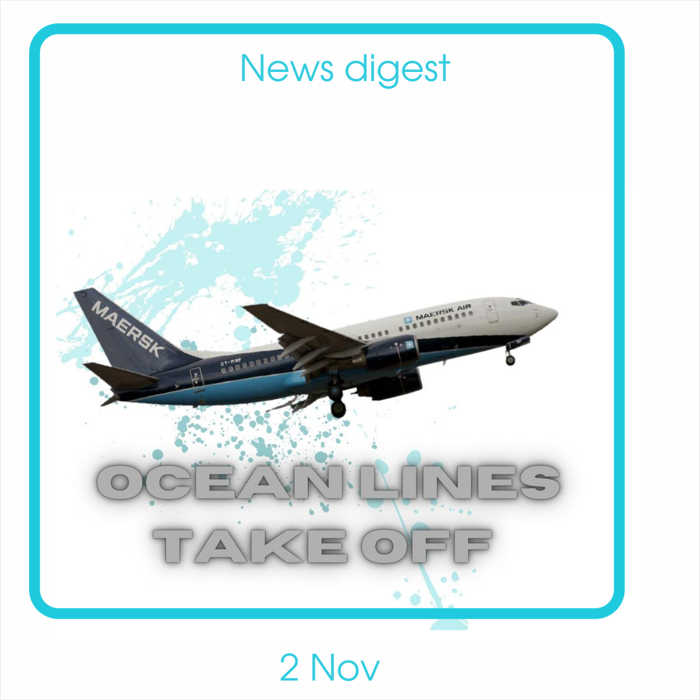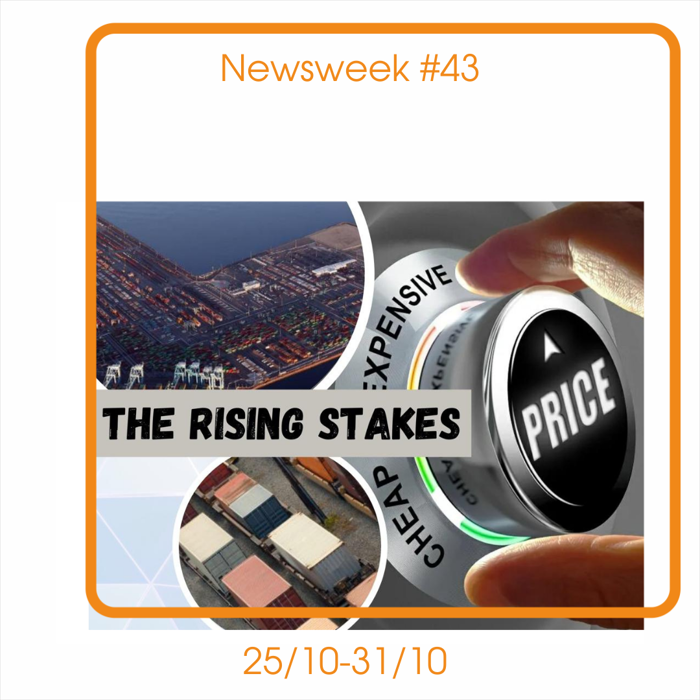What goes around comes around: years of underinvestment in airfreight are now resulting in decrease in volumes and the sector’s inability to battle congestion.
Although strong demand for air has taken off, it is not quite clear where exactly it is heading. Judging by the fact that global load factors fell by 1.5%, it is on the way to the abyss of an uncertain future. There is a lot of congestion in the EU (volumes out of Europe fell 10%), across the Atlantic, and in Asia, and many charters are being refused. It is the price that the whole industry has to pay for years of neglect of the investment in air and handling cargo. In fact, this devastating crisis has occurred for the first time in the last 25 years. The logistics industry is in desperate need of more staff – not only airport operators. The off-airport movement of cargo is worsened by a shortage of thousands of truck drivers in European countries. The air rate is currently double from what it was the same time a year ago – $14/kg from China to the U.S. West Coast. Yet, even this significant increase does not make airfreight more expensive than the transportation of goods by sea. On the contrary, many companies are trying to make up for a lost time by shifting goods that normally move by the ocean to air. If before the COVID, the average price to move air cargo was about 13 to 15 times higher than the one by the ocean, now it is only 3-5 times more expensive. However, both sectors are equally affected by the disastrous schedule reliability. The congestion in Frankfurt is causing major delays in other airports. The last nail in the coffin was the introduction of the Union Customs Code, which, according to experts, is a big omission during the peak season. With the growing prices, it is inevitable that service levels will go down, and the challenge will push for months ahead. To address the situation, local partners are teaming up to provide additional space for shortages and refuse short-time working to increase the availability of the employees. However, since the drivers’ shortages are not solved, the measures will not be a game-changer. There is now a new veil of uncertainty regarding the relations between independent hauliers and self-employed drivers. The UK government is advising to abstain from the services of the latter claiming that it could result in the traffic commissioner revoking their license. The customers are asked to go to agencies but instead, limited companies, are choosing to go to Germany rather than work through an agency because by doing so they instantly get a license uplift or extra drivers.
In the meantime, the implementation of the shocking container dwell fee in the Ports of LA and Long Beach has been postponed thanks to the progress that has been made in shedding long-dwelling containers. However, the initiative still will be implemented later in November because all the collected fees will be spent on programs designed to enhance efficiency, accelerate cargo velocity and address congestion impacts. Europe sees some changes too as some of the companies previously stated that they would omit congested Port of Hamburg reinstate their loop call, although the relief is not expected any time soon. As for the previously announced shift to tech and research, the first results did not make us wait. The Blue Essence has become the first offshore certified USV that can launch an electrically remote-controlled underwater robot at the Port of Rotterdam. Personnel can be moved from high-risk offshore environments to a control room onshore, reducing the CO2 footprint by 95% compared to traditional research methods. The trend for technological development does not overrun the trend of acquisitions and partnerships as this week sees new ambitious plans. Maersk sets its eyes on South Africa by tapping into a partnership with freight transportation company Grindord and taking 51% of shares. The step follows Maersk’s recent a long-term strategic partnership with wind turbine manufacturer Vestas for all containerized transport. Meanwhile, Wan Hai Lines knows the drill of the growing influence of the shipping lines and hurries to strengthen its positions by purchasing one of its chattered ships. The move is justified – the current context of tight capacity requires vessels that are at an immediate availability and this is where second-hand ones come in handy.
Apart from baring all the pain points of the industry, the crisis has definitely accelerated the development of facilities that used to be unimaginable. A bright example of it is the existence of the trains between the major sea ports along the New Silk Road, a phenomenon that used to be a distant dream but a reality now. The data shows that container transport by rail between Europe and China has grown by 25% in 2021. Experts say that is mostly driven by food transport. The Georgia Port is betting on the rail to and announces the operation of the second set of new rail tracks at the Port of Savannah. It is a part of the plan to invest $34 million into the port to help it expedite an additional 1.6 million TEU in capacity the delivery of which will be split into two phases.

FMC has had a lot on its plate lately – apart from trying to hold back the growing influence of the big companies, it is now attempting to battle shippers that are being very peaky with the terminals. Instead of choosing a more or less relived port, they are aiming for big ones and it only creates more blockages. With the US consumption demand showing a 25% increase, shippers will have to push away their aspirations and face the reality – even the decreasing rates will not make their lives easier. Although the American government is going in favor of its biggest infrastructure programme, the changes will take a long time to come into effect. Meanwhile, the snowball of incontrollable congestion is about to start sliding back onto intra-Asia routes. The alternatives by rail and air remain in a complicated state as the development of the former requires improvement of intermodal service and the latter is going through a new stage of rate increases. We are in for another “heat waves” of perplexities for 2022, so it is definitely high time to buckle up.
The need for fundamental changes is obvious but it does not happen overnight and requires a much more comprehensive approach, thus big players team up with research institutions following the famous “knowledge is power” motto. The mutual commitments aim to bring the long-awaited tech boost and enhance the already existing capabilities. The industry has already seen successful advances, the sustainable initiatives – a new roadmap to decarbonizationhas seen the light this week. MAXMODAL is on the lookout for emerging trends to provide you with a quality overview. Join us now!

The new era will be all about technology revolutionizing logistics and transportation markets that are already welcoming fruitful collaborations among research institutions and major players.
Technocrats can definitely cheer “hurray!” as companies start switching their focus toward technical development that is absolutely essential if one wants to build resilient supply chains that would correspond to the challenges of the market in the present as well as in the future. Maersk is striving to be the leader in every initiative and teaming up with MIT Center to accelerate its abilities and renovate its strategies based on collaborative research and mutual commitments. This partnership follows Maersk’s recent Maersk long-term strategic work with wind turbine manufacturer Vestas for all containerized transport. Meanwhile, educational institutions tap into the big game in the Netherlands under the leadership of the Port of Rotterdam. They are going to access the ports’ capabilities and current market trends from the scientific point of view and provide solutions that could help improve general management and leadership. The design of the future training program for employees is also included; it aims to tackle the problem of underqualified labor.
At the same time, the debates and reflections on the consolidating of the industry continue. There are emerging players who actually start seeing it as an opportunity for diversification of their strategy rather than a monopoly threat. They also believe that their “neutral” status on the market will be more appealing to the customers in contrast with rigorous giants that are driven, according to these commentators, only by their greed. Besides, the cultural divide between the groups is just too great and allows everyone to find their niche and continue to grow. This is a controversial premise because it is impossible to doubt that some big players’ expansion strategy has limited the ability of some freight forwarders to access capacity on its ship on the main trade lines. In addition, such giants start taking over e-commerce in the light of a targeted acquisition strategy. This is a major shift in contractual relations that is highly difficult to break through if you are a small company. Will it be a good cop vs bad cop kind of competition? The customers will have to decide. It is challenging to fully concentrate on the long-run strategies when right here, right now, cargo is still not being delivered on time – schedule reliability remains one the sorest pain points. Even the attempts to omit the troublesome ports cause no improvement as everyone misses the deadlines. If congestion at the Ports of LA and Long Beach seemed insane, it is now breaking all records as, according to the reports, ships are literally queuing up 150 miles from shore. In the desperate need of space, the Port of Savannah has to use a small airport in Georgia as a temporary overflow yard. Never have the new marine transportation system ever been needed as it is now. Moreover, this chaos is sliding down towards intra-Asia trade lanes. There are large amounts of cargo stuck at transhipment hubs in the south-east, and many carriers keep blanking their sailings that, in turn, keeps pushing spot rates further down.
In addition to the challenging situation at sea, the congestion of some European airports is contributed to the rising competition between forwarders. As a response, Flexport has launched a weekly air charter service from Hong Kong to Paris-CDG Airport. However, any new steps are difficult to implement in the EU due to the recent new customs regulations in Germany. Any cargo sent to Frankfurt, for example, will take more time to clear, thus the delays are inevitable.
To deal with the growing demand, railway companies are trying to provide new services as well. The recent one takes place from Helsinki to Zhengzhou provided by Nurminen Logistics. The choice of Helsinki is a fair one as it is a hub for both – rail and port connections. Besides, there is hardly any congestion, so in the rush of the holiday season, the line will be a savior. Will the anticipated Rail Baltica be as efficient? Unfortunately, the long-awaited project will not meet its deadline by 2026 because of the classic issue – rising construction costs. COVID-19 is not the only one to blame. The miscommunication among the involved parties postponed the signing of the agreements that could boost the development. Spain could do better with its railway innovation as well, experts say. Despite sufficient infrastructure, the country simply is not using its potential. The problem originates from such issues as the fact that there is no level playing field between road and rail transport regarding the pricing offers and the external costs paid, and the government has been falsely prioritizing passenger freight over transportation. Perhaps, more strategic partnerships could boost the improvement. For instance, the restoration of trade via rail between China and North Korea is enormously changing the situation in a positive direction.
It is clear as daylight that the industry needs a technological push, and it is arriving. As companies start teaming up with the research institutions, this quintessence of efforts will eventually bring the needed technology. Sustainable development serves as proof. After continuous studies, Logistics UK has introduced a route map to decarbonize the sector.

Apparently, shippers suffering from congested ports are the problem themselves. How does the desire to increase financial assets postpone the awaited recovery?
By now, long-lasting global congestion (with Australia becoming an honorable member) has proven that there are always players that are benefiting from the constraints. Traditionally it has been the shipping lines, but now the new ones are coming into the spotlight. It has been revealed that some carriers that have investment stakes in different terminals chose to wait for days offshore until a particular terminal becomes available instead of using a terminal that has a much shorter berthing backlog. In the meantime, they are making money from the huge amount of demurrage. The FMC is expected to address this issue, but in reality, it has no executive power to navigate it. Such maneuvers are postponing the awaited recovery, so if the crisis continues into 2022, the suffering carriers themselves are part of the problem. If they think that other factors influencing the current context will loosen their grip, the hopes are intended to fail. Thus, such companies as Wan Hai Lines chose to anticipate financial losses and resign their ships from the congested west coast. The demand alone keeps growing. The latest updates show a 25% jump in total personal consumption in the year to September on the US market. However, the government is not planning to surrender. On the contrary, it going to launch (since the 30s) its largest infrastructure programme with the landmark equal to a $1.2 trillion package. The major part will be sent on transport funding with an emphasis on roads and bridges. In addition, the action plan will increase federal flexibilities for port grants to release congestion and strengthen long-term supply chain resiliency. Rail is not left alone either – 66 billion dollars will go to the national rail network.
Meanwhile, Germany is also preoccupied with railway issues. In particular, it is planning to tackle the issue of the forming monopoly, so the Monopoly Committee is pushing onto a division of the DB Group. However, the officials’ concerns do not change the growing influence of the big companies – neither in the rail sector nor at sea. According to the data, the top eight liner companies now control 81% of global capacity. Ocean carrier consolidation also keeps expanding, as they have been vigorously placing orders and making new acquisitions. Maersk’s orderbook totals 6% of its on-the-water capacity, CMA CGM’s orders-to-fleet ratio is at 17%, HMM and Cosco 20%. The reign of the marine giants is happening with the free-falling spot rates in the background. The latest drop occurred at 4.9% in the first week of November. Experts warn that shippers hoping to bag bargain ocean freight prices anytime soon are likely to face disappointment. This is why long-term contracts are becoming the new gold as companies are striving for any guarantees in this uncertain time. Maersk has gotten into partnership with the energy solutions provider Vestas for all containerized transport. Apart from building a resilient supply chain, they will also focus on sustainable objectives. In addition to the new green initiatives, the ports of Long Beach and LA will encourage the trucking industry to invest in cleaner vehicles and reach zero emissions by collecting its Clean Truck Fund Rate starting from April 2022.
In contrast to ocean spot rates, airfreight rates are climbing further. Already elevated Hong Kong to North America and Shanghai Pudong to North America average prices increased 76% and 89%. In Europe, average prices for airfreight traffic from Hong Kong and Shanghai climbed 78% and 63% year-over-year. In the long run, companies are preparing for an increase in the appetite for passenger to freighter conversions and the impact of that capacity on the market. Amazon and Maersk are planning to deploy more long-haul widebody aircraft.
Although it is the US ports’ turn to disrupt schedule reliability, the UK’s Felixstowe is adding logs into the fire. The alternative routes from the ports are a complicated issue because they require facilitation of better intermodal freight services and land purchases. There are now calls for urgent remodelling of lines in and around the Cambridgeshire town of Ely. However, the Mediterranean corridor comes in handy – a new direct railway line has been opened between the Spanish port of Alicante and London. The move is especially important for the fruit and vegetable sector, so oranges will be on the Christmas table for sure.

Surcharges are now coming in chunks. Shippers worldwide are fed up with never-ending fees, and even the slightly decreased spot rates are no longer a game-changer.
There might have been a glimpse of a decrease in spot rates on a global scale, but shippers are being fed with more and more surcharges, which saturate even the slightest improvement on the market. They buckle up for the new FAK rates to come in chunks. The desperation to have their cargo delivered forces shippers to comply just to have a guarantee that the contract agreements will be fulfilled. With the new so-called “excess container dwell” fees imposed in California’s ports, the burden becomes almost unbearable. At least, more experts agree that the plateauing of the container shipping markets has passed and now we are on the way to the decline. Indeed, in the past several weeks, the spot rates did not show new highs. The Shanghai-Los Angeles rate dropped $1,119 per feu to a level of $9,857 for the first time since July. A similar trend is seen from Shanghai to New York with rates dropping $887 per feu to $12,667. However, a logical question arises in this case – how long will it last, can we be confident that the numbers will not bounce back to the elevated levels? It all started with the increased demand that pushed the rates up, and the new forecasts predict that it will not decline. The demand is driven mostly by American consumers and since this is where there is the most congestion right now, the situation will take months to resolve, most probably all way into 2022. Such measures as the implementation of the 24/7 operating schedule have not been successful either. The scarcity of chassis is affecting all types of moves, from local deliveries to terminal moves to/from off-dock rail ramps despite the fact that local trucking delays have been reduced. Thus, such companies as Maersk chose to focus on the growth on the landside of their business and acquisition in the logistics space. Noting on acquisitions, CMA CGM Group has bought a 90% stake in the FMS terminal in Los Angeles. Indeed, the storm is temporary – when congestion is resolved, the company will be left with a very powerful facility. It is wise especially when the airfreight rates are flying up again. Overall air cargo rates are up +155% and +37% in October 2021 versus October 2019 and October 2020.
In addition to growing surcharges, another kind of expense will rise – the canal costs. The move is justified by the initiative of The Panama Canal Authority to start green transitioning. It will require more or less a $70bn long-term development programme to take the canal to zero-carbon emissions by 2050. It will also introduce a new “differentiated tariff scheme”, which will see less-polluting vessels, charged lower prices for the reduction in greenhouse gases emitted. At the same time, the Suez Canal has announced an increase of 6% in charges from February on all vessels except cruise ships and LNG tankers that suffered in the pandemic the most. The authorities are trying to attempt to fix the financial losses with the expenses of those who are able to pay and to take off the pressure from the kinds of vessels that are struggling. Meanwhile, Maersk also joins another sustainable initiative as a part of the First Movers Coalition together with such global brands as Apple and Amazon. It is a platform where companies make purchasing commitments to create early markets for important technologies needed to achieve net-zero by 2050. Maersk has set a goal to achieve at least 5% of its deep-sea shipping operations powered by zero-emission fuels by 2030. The Port of Valencia tunes into the partnership with the Port of Hamburg with emphasis on the promotion of hydrogen aiming for the same 2030 deadline as the majority of the players that want to go carbon-free.
We are on the highway to h…historic highs on the road. While in the marine sector, there is a slight decrease in spot rates, road freight rates have hit the fifth consecutive quarter of European road freight rate increases. Topped with widespread cost inflation up to the end, driver shortage and rising fuel prices this dynamic is set for the downfall. The issue of the lack of labor has been especially painful. The reason why it still has not been resolved is the fact that the sector remains unattractive, some experts believe, so governmental regulation regarding better the treatment of drivers is needed ASAP. The volumes are expected to keep increasing – in the UK alone the highest price-per-mile average across all vehicle types was in September 2021 — a 21.8%. The country has been trying to address this problem for months, although the focus is still on rail. Perhaps, it is because the railway sector has been the only one that is returning to pre-2019 levels. With passenger numbers coming back to network, it has the potential to play a key role in the government’s agenda, supporting economic growth, investment and jobs. However, in the international arena not everything is so positive for rail. The North-South International Transport Corridor connecting Russia with India via Iran has been put on hold and the issue is much deeper than Iran’s rail underdevelopment. The game involves Armenia and Azerbaijan having contradicting agendas spiced up with political tension. The latter dimension will determine the outcome of the project.

Ocean rates have been hovering in the clouds for a long time, opening up airspace for new players. This time for Maersk.
Maersk is not just buying everything on its way when it comes to the expansion of its marine fleet, but it is also doing the same in the airfreight sector. It is already a shipping giant, so now the company is planning to expand its presence in the air. This is not something new – back in the day its competitor CMA CGM pushed more into airfreight. Maersk’s ambition is to have approximately 1/3 of its annual air tonnage carried within its own controlled freight network. The initiative is possible thanks to the company’s outstanding performance – with revenues up 68% year-on-year to $16.6bn. Switching to a more promising transportation sector does seem like a wise strategy as congestion continues to saturate the future. The local pain points have proven to have caused damage worldwide so it is no wonder that the US is calling for international support. During the G20 summit, the participants agreed that the key is in cooperation between government and the private sector that can better anticipate and respond to shortages that may be coming down the pike. The concerns are justified because of the alarming delays and moreover, the environmental threat the misfortunate blockages in southern California possess (despite the Port of LA meeting its emission goals earlier than 2023). The conditions are complicated and the government is working closely with the ports to improve cargo velocity. So far, it is the infrastructure improvements that have been the focus of the authorities. California’s agreement with the US Department of Transportation will work on a series of projects amid to improve financial context, facilitate environmental development, etc.
While the big plans are still in the making, the shipping lines continue riding the wave of success. If before the profits seemed only sky-high, now they are cosmic. The recent updates have shown, that the big players are on the way to unimaginable (in the past 20 years) $200bn. Some of them are even expanding – China Merchants Energy Shipping has taken control of Sinotrans Container Lines in a deal worth around $344m. The trend of the lines’ domination is expected to keep up as forecasts assume a relatively more resilient freight rate and current shipping conditions to persist in 2022. Speaking of the former, the forwarders are still trying to negotiate for long-term freight contracts aiming for the predictability. However, the clogged supply chains are making it impossible. At the same time, surcharges keep risingdue to the remaining elevated demand and tight capacity. The new Peak Season Surcharges will be US$1,000 per unit of all types for Europe and America. Paired with disrupted schedule reliability, more and more carriers will show low performance. Evergreen has already set an unimpressive bar – it has managed to get just 13.2% of its ships into port on time in Q3. With hundreds of ships still waiting at berth, the situation will remain troublesome, if not worse, it risks accelerating.
Despite the uncertain future, India is doing much better in the present. Although never-ending congestion has caused severe headaches to the supply chains all over the world, the country seems to have gotten its external trade in control slowly and gradually. The focus on technological advances is its main priority now in attempts to reduce dependency on ships. As for the innovation, is the hyperloop still a dystopian technology? At least, in the Netherlands, it is becoming more realistic for cargo. If it is implemented, it will result in a one-million-tonne reduction in CO2 emissions and could lead to a significant improvement in air quality. In addition, it requires fewer investments than the ones in road. The discussion has been brought to the table by Hardt Hyperloop in light of its collaboration with other companies.
Winter is coming and so is more energy consumption. Rail, being traditionally the go-to alternative method of transporting cargo, has been put under close investigation in the UK as to whether it is that worthy of investment. The concerns have been awakened by the fact that increasing energy costs may discourage freight operators from sending freight by rail instead of reverting to road transport. However, with all the investments being made and overall support of the intermodal shift to rail, the concerns were soon bashed. At the same time, the DB Cargo and DHL back railway focus by planning to transport more parcels by rail. The joint effort will open new possibilities for cargo flows between the companies. In addition, the sector has welcomed a new connection between Italy and Russiawhere all types of cargo can be transported from heavy goods to alcohol. With all the developments, there is should be something to celebrate with, shouldn’t it?
Perhaps, Amazon will not be able to share the festive mood for quite a while. Halloween might be over, but the nightmares are not. The company is bracing itself for several billion dollars of additional operating costs by the end of the year due to staff shortages, decreased transport capacity, etc. Even its recent initiative to invest in the expansion of its own in-house delivery capabilities is worth it. Meanwhile, DP World is setting its own distribution hub with OASIS Group to facilitate trading infrastructure.

Although the week kicked off with rather high hopes regarding plunged leasing and trading prices, it was soon covered in hues of increasing electricity rates and insurance fees. In addition to the already big bills, shippers that are waiting for their cargo to get through the congested ports in California will also face more charges for having their ships at berth. It seems like if anyone ever manages to drag themselves through these blockages, the survivors will end up having empty pockets. Containers are being stuck on top of each other to save space while some players choose non-operational ports to gain more capacity. Big financial expenses are forcing countries to speed up the development of their logistics and transportations sectors. Thus, China is vigorously moving towards Europe, strengthening its connection with the Port of Hamburg and relying on the recent acquisitions. Russia follows suit and embraces the development of rail. Big changes are on the way thanks to its project designed to connect the ports of the Pacific and Indian Oceans with the Northern Sea Route.
Environmentalists have been alarmed by the fire outbreak on the ZIM ship that has sparked concerns about whether it would be harmful to the waters around it. However, despite the incident, green direction has seen a significant breakthrough in the past several days. The contributors are the Port of Long Beach that has reported record reductions in diesel particulates and nitrogen oxides, meeting its 2023 goal, and more companies that are switching to sustainable fuel. As usual, MAXMODAL remains your reliable source of the latest updates. Sign up to stay tuned.





